Advanced Management Accounting Report: Financial and Business Analysis
VerifiedAdded on 2020/11/23
|13
|3882
|370
Report
AI Summary
This report delves into advanced management accounting, exploring the purpose of presenting financial information to stakeholders, including shareholders, creditors, and customers, emphasizing its role in evaluating performance and guiding future objectives. It examines various microeconomic techniques like cost accounting, marginal costing, absorption costing, standard costing, cost-volume-profit analysis, capital budgeting, and budgetary control, outlining their advantages and disadvantages. The report also highlights the impact of internal and external business environment factors on management accounting, providing a comprehensive overview of how these techniques facilitate strategic decision-making, cost management, and performance enhancement within organizations like Tesco. The analysis covers techniques used for cost computation, reduction and control, investment feasibility, and future financial planning.
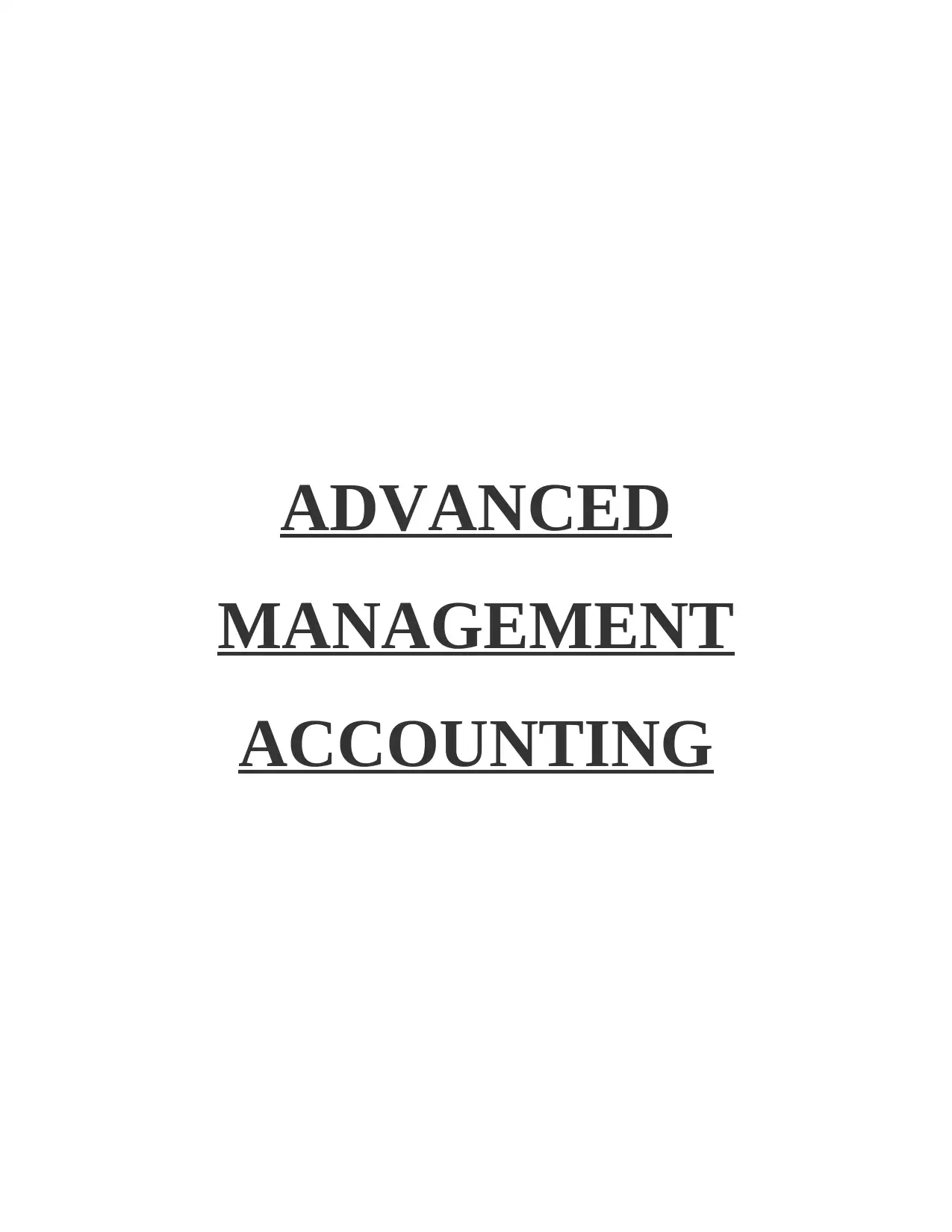
ADVANCED
MANAGEMENT
ACCOUNTING
MANAGEMENT
ACCOUNTING
Paraphrase This Document
Need a fresh take? Get an instant paraphrase of this document with our AI Paraphraser
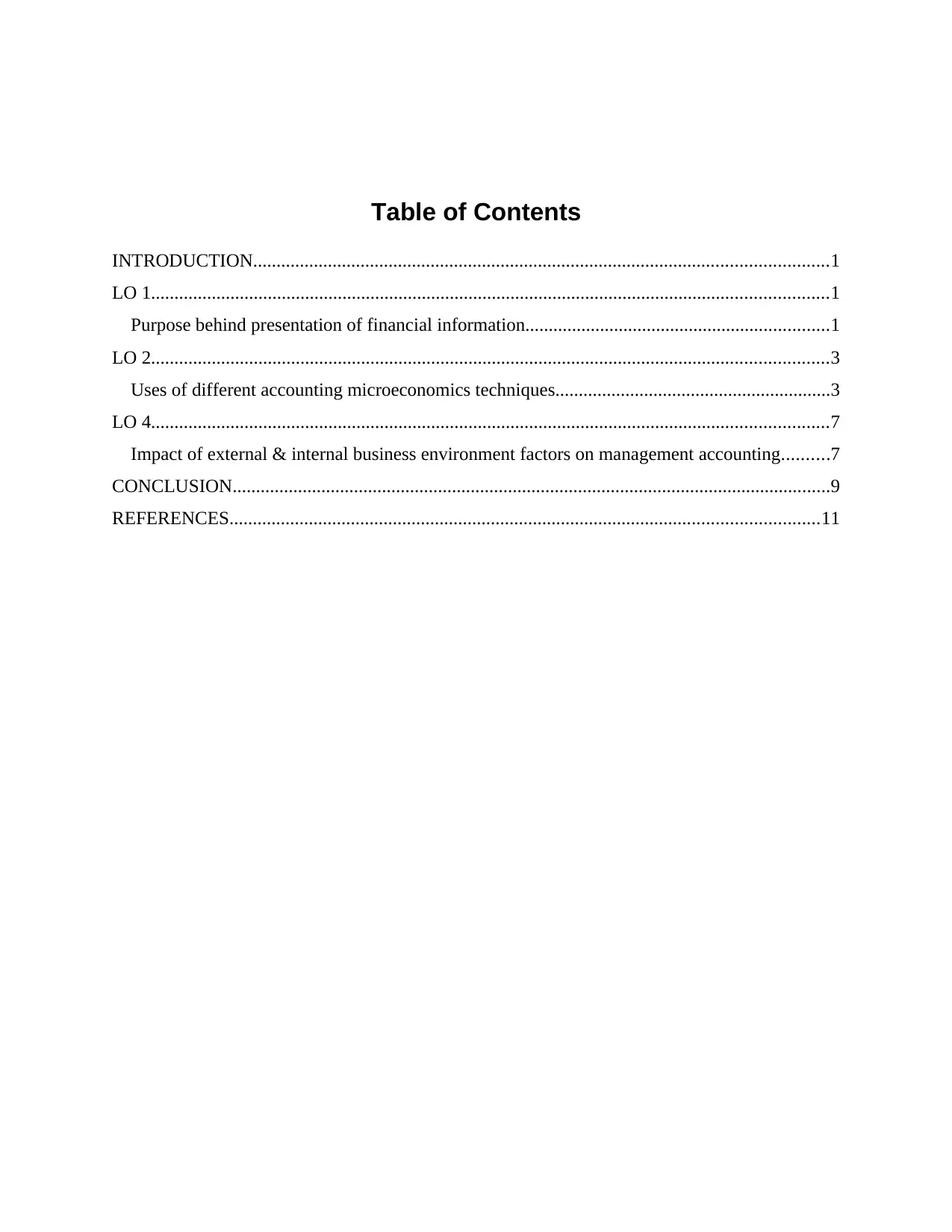
Table of Contents
INTRODUCTION...........................................................................................................................1
LO 1.................................................................................................................................................1
Purpose behind presentation of financial information.................................................................1
LO 2.................................................................................................................................................3
Uses of different accounting microeconomics techniques...........................................................3
LO 4.................................................................................................................................................7
Impact of external & internal business environment factors on management accounting..........7
CONCLUSION................................................................................................................................9
REFERENCES..............................................................................................................................11
INTRODUCTION...........................................................................................................................1
LO 1.................................................................................................................................................1
Purpose behind presentation of financial information.................................................................1
LO 2.................................................................................................................................................3
Uses of different accounting microeconomics techniques...........................................................3
LO 4.................................................................................................................................................7
Impact of external & internal business environment factors on management accounting..........7
CONCLUSION................................................................................................................................9
REFERENCES..............................................................................................................................11
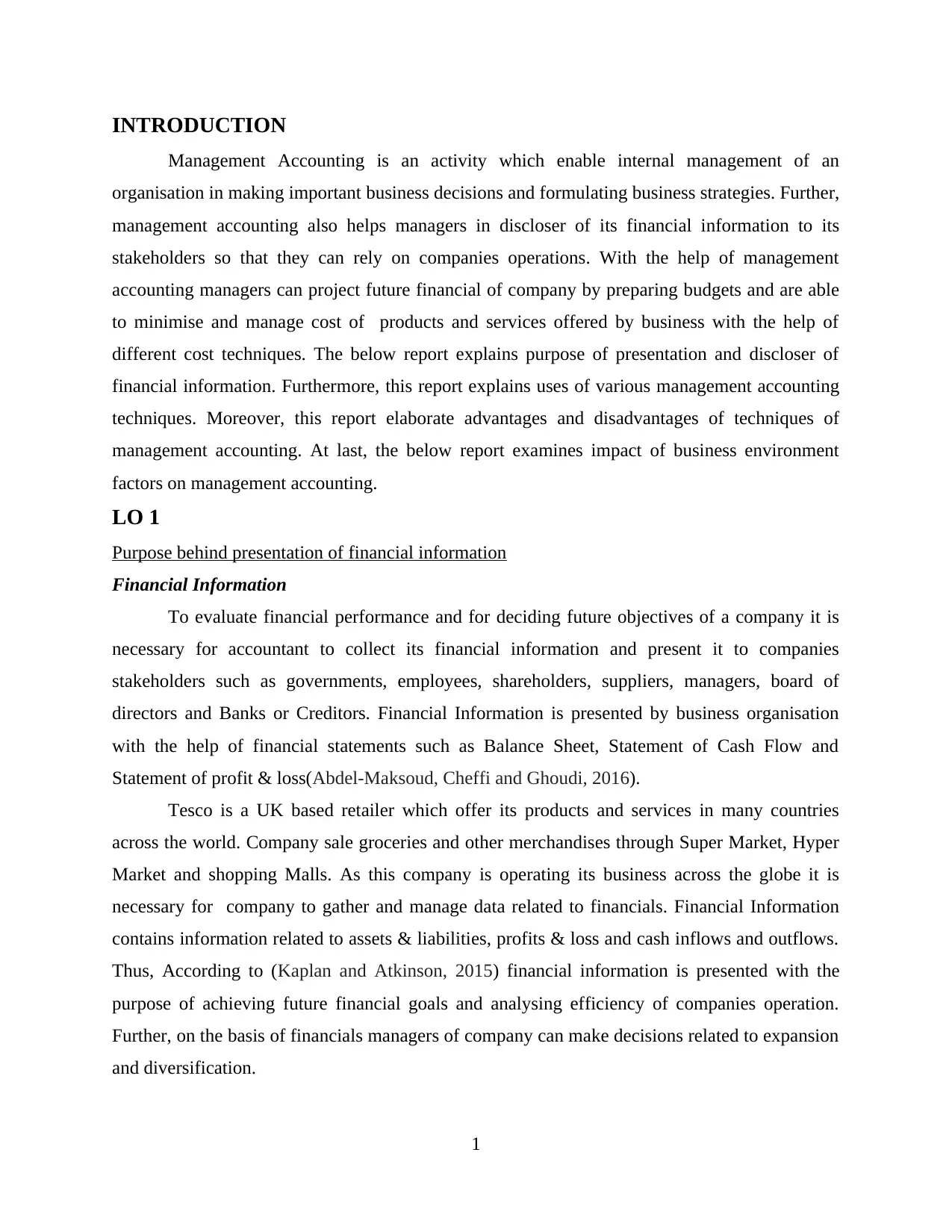
INTRODUCTION
Management Accounting is an activity which enable internal management of an
organisation in making important business decisions and formulating business strategies. Further,
management accounting also helps managers in discloser of its financial information to its
stakeholders so that they can rely on companies operations. With the help of management
accounting managers can project future financial of company by preparing budgets and are able
to minimise and manage cost of products and services offered by business with the help of
different cost techniques. The below report explains purpose of presentation and discloser of
financial information. Furthermore, this report explains uses of various management accounting
techniques. Moreover, this report elaborate advantages and disadvantages of techniques of
management accounting. At last, the below report examines impact of business environment
factors on management accounting.
LO 1
Purpose behind presentation of financial information
Financial Information
To evaluate financial performance and for deciding future objectives of a company it is
necessary for accountant to collect its financial information and present it to companies
stakeholders such as governments, employees, shareholders, suppliers, managers, board of
directors and Banks or Creditors. Financial Information is presented by business organisation
with the help of financial statements such as Balance Sheet, Statement of Cash Flow and
Statement of profit & loss(Abdel-Maksoud, Cheffi and Ghoudi, 2016).
Tesco is a UK based retailer which offer its products and services in many countries
across the world. Company sale groceries and other merchandises through Super Market, Hyper
Market and shopping Malls. As this company is operating its business across the globe it is
necessary for company to gather and manage data related to financials. Financial Information
contains information related to assets & liabilities, profits & loss and cash inflows and outflows.
Thus, According to (Kaplan and Atkinson, 2015) financial information is presented with the
purpose of achieving future financial goals and analysing efficiency of companies operation.
Further, on the basis of financials managers of company can make decisions related to expansion
and diversification.
1
Management Accounting is an activity which enable internal management of an
organisation in making important business decisions and formulating business strategies. Further,
management accounting also helps managers in discloser of its financial information to its
stakeholders so that they can rely on companies operations. With the help of management
accounting managers can project future financial of company by preparing budgets and are able
to minimise and manage cost of products and services offered by business with the help of
different cost techniques. The below report explains purpose of presentation and discloser of
financial information. Furthermore, this report explains uses of various management accounting
techniques. Moreover, this report elaborate advantages and disadvantages of techniques of
management accounting. At last, the below report examines impact of business environment
factors on management accounting.
LO 1
Purpose behind presentation of financial information
Financial Information
To evaluate financial performance and for deciding future objectives of a company it is
necessary for accountant to collect its financial information and present it to companies
stakeholders such as governments, employees, shareholders, suppliers, managers, board of
directors and Banks or Creditors. Financial Information is presented by business organisation
with the help of financial statements such as Balance Sheet, Statement of Cash Flow and
Statement of profit & loss(Abdel-Maksoud, Cheffi and Ghoudi, 2016).
Tesco is a UK based retailer which offer its products and services in many countries
across the world. Company sale groceries and other merchandises through Super Market, Hyper
Market and shopping Malls. As this company is operating its business across the globe it is
necessary for company to gather and manage data related to financials. Financial Information
contains information related to assets & liabilities, profits & loss and cash inflows and outflows.
Thus, According to (Kaplan and Atkinson, 2015) financial information is presented with the
purpose of achieving future financial goals and analysing efficiency of companies operation.
Further, on the basis of financials managers of company can make decisions related to expansion
and diversification.
1
⊘ This is a preview!⊘
Do you want full access?
Subscribe today to unlock all pages.

Trusted by 1+ million students worldwide
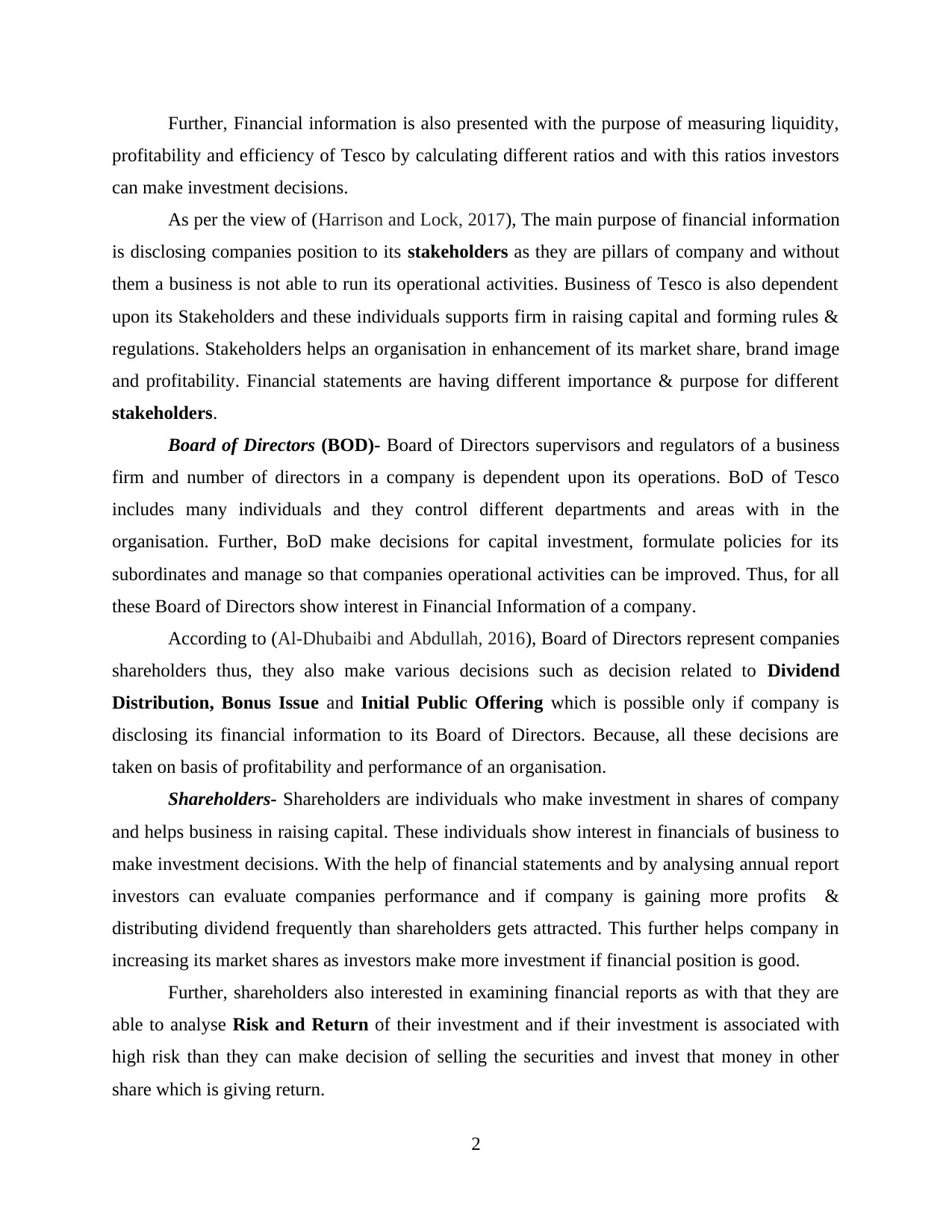
Further, Financial information is also presented with the purpose of measuring liquidity,
profitability and efficiency of Tesco by calculating different ratios and with this ratios investors
can make investment decisions.
As per the view of (Harrison and Lock, 2017), The main purpose of financial information
is disclosing companies position to its stakeholders as they are pillars of company and without
them a business is not able to run its operational activities. Business of Tesco is also dependent
upon its Stakeholders and these individuals supports firm in raising capital and forming rules &
regulations. Stakeholders helps an organisation in enhancement of its market share, brand image
and profitability. Financial statements are having different importance & purpose for different
stakeholders.
Board of Directors (BOD)- Board of Directors supervisors and regulators of a business
firm and number of directors in a company is dependent upon its operations. BoD of Tesco
includes many individuals and they control different departments and areas with in the
organisation. Further, BoD make decisions for capital investment, formulate policies for its
subordinates and manage so that companies operational activities can be improved. Thus, for all
these Board of Directors show interest in Financial Information of a company.
According to (Al-Dhubaibi and Abdullah, 2016), Board of Directors represent companies
shareholders thus, they also make various decisions such as decision related to Dividend
Distribution, Bonus Issue and Initial Public Offering which is possible only if company is
disclosing its financial information to its Board of Directors. Because, all these decisions are
taken on basis of profitability and performance of an organisation.
Shareholders- Shareholders are individuals who make investment in shares of company
and helps business in raising capital. These individuals show interest in financials of business to
make investment decisions. With the help of financial statements and by analysing annual report
investors can evaluate companies performance and if company is gaining more profits &
distributing dividend frequently than shareholders gets attracted. This further helps company in
increasing its market shares as investors make more investment if financial position is good.
Further, shareholders also interested in examining financial reports as with that they are
able to analyse Risk and Return of their investment and if their investment is associated with
high risk than they can make decision of selling the securities and invest that money in other
share which is giving return.
2
profitability and efficiency of Tesco by calculating different ratios and with this ratios investors
can make investment decisions.
As per the view of (Harrison and Lock, 2017), The main purpose of financial information
is disclosing companies position to its stakeholders as they are pillars of company and without
them a business is not able to run its operational activities. Business of Tesco is also dependent
upon its Stakeholders and these individuals supports firm in raising capital and forming rules &
regulations. Stakeholders helps an organisation in enhancement of its market share, brand image
and profitability. Financial statements are having different importance & purpose for different
stakeholders.
Board of Directors (BOD)- Board of Directors supervisors and regulators of a business
firm and number of directors in a company is dependent upon its operations. BoD of Tesco
includes many individuals and they control different departments and areas with in the
organisation. Further, BoD make decisions for capital investment, formulate policies for its
subordinates and manage so that companies operational activities can be improved. Thus, for all
these Board of Directors show interest in Financial Information of a company.
According to (Al-Dhubaibi and Abdullah, 2016), Board of Directors represent companies
shareholders thus, they also make various decisions such as decision related to Dividend
Distribution, Bonus Issue and Initial Public Offering which is possible only if company is
disclosing its financial information to its Board of Directors. Because, all these decisions are
taken on basis of profitability and performance of an organisation.
Shareholders- Shareholders are individuals who make investment in shares of company
and helps business in raising capital. These individuals show interest in financials of business to
make investment decisions. With the help of financial statements and by analysing annual report
investors can evaluate companies performance and if company is gaining more profits &
distributing dividend frequently than shareholders gets attracted. This further helps company in
increasing its market shares as investors make more investment if financial position is good.
Further, shareholders also interested in examining financial reports as with that they are
able to analyse Risk and Return of their investment and if their investment is associated with
high risk than they can make decision of selling the securities and invest that money in other
share which is giving return.
2
Paraphrase This Document
Need a fresh take? Get an instant paraphrase of this document with our AI Paraphraser
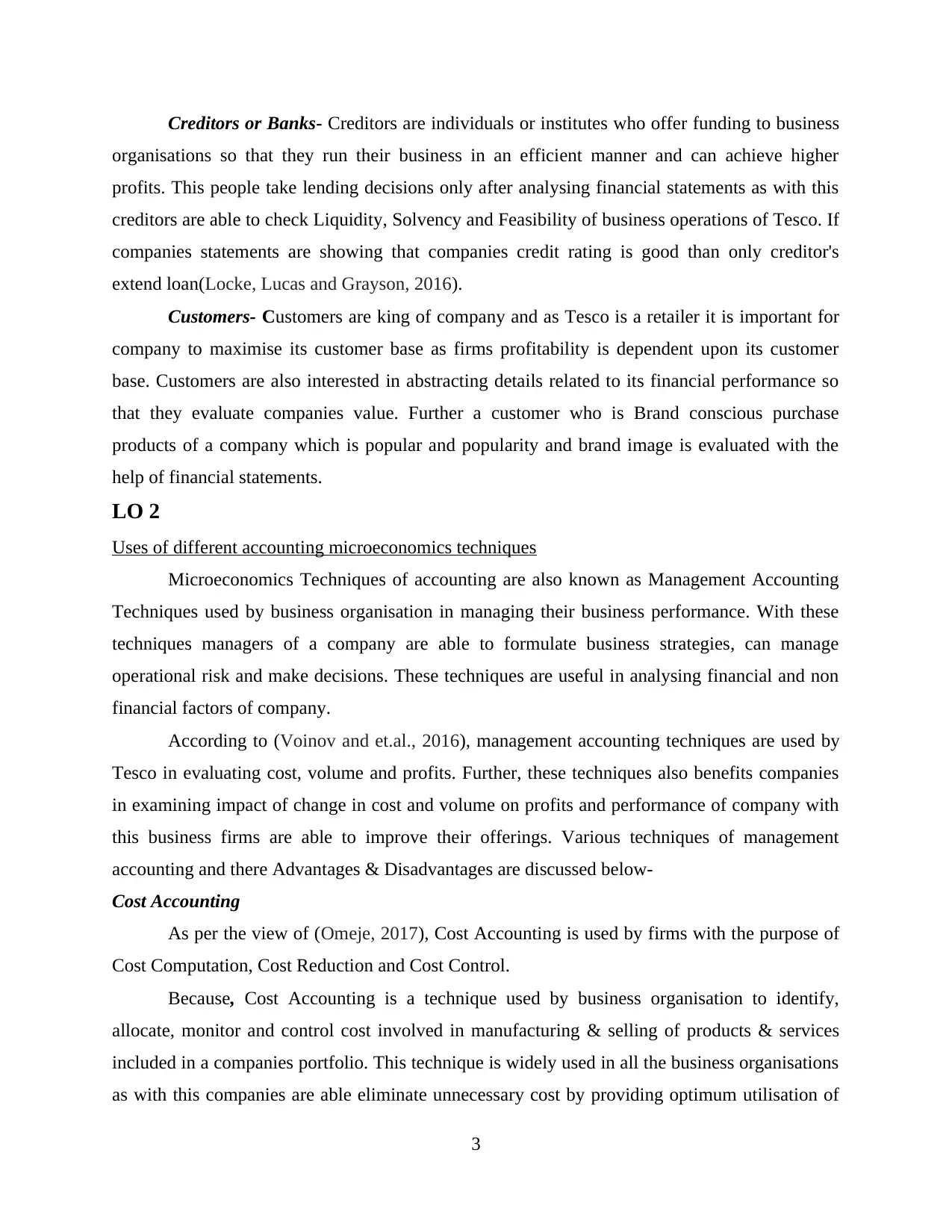
Creditors or Banks- Creditors are individuals or institutes who offer funding to business
organisations so that they run their business in an efficient manner and can achieve higher
profits. This people take lending decisions only after analysing financial statements as with this
creditors are able to check Liquidity, Solvency and Feasibility of business operations of Tesco. If
companies statements are showing that companies credit rating is good than only creditor's
extend loan(Locke, Lucas and Grayson, 2016).
Customers- Customers are king of company and as Tesco is a retailer it is important for
company to maximise its customer base as firms profitability is dependent upon its customer
base. Customers are also interested in abstracting details related to its financial performance so
that they evaluate companies value. Further a customer who is Brand conscious purchase
products of a company which is popular and popularity and brand image is evaluated with the
help of financial statements.
LO 2
Uses of different accounting microeconomics techniques
Microeconomics Techniques of accounting are also known as Management Accounting
Techniques used by business organisation in managing their business performance. With these
techniques managers of a company are able to formulate business strategies, can manage
operational risk and make decisions. These techniques are useful in analysing financial and non
financial factors of company.
According to (Voinov and et.al., 2016), management accounting techniques are used by
Tesco in evaluating cost, volume and profits. Further, these techniques also benefits companies
in examining impact of change in cost and volume on profits and performance of company with
this business firms are able to improve their offerings. Various techniques of management
accounting and there Advantages & Disadvantages are discussed below-
Cost Accounting
As per the view of (Omeje, 2017), Cost Accounting is used by firms with the purpose of
Cost Computation, Cost Reduction and Cost Control.
Because, Cost Accounting is a technique used by business organisation to identify,
allocate, monitor and control cost involved in manufacturing & selling of products & services
included in a companies portfolio. This technique is widely used in all the business organisations
as with this companies are able eliminate unnecessary cost by providing optimum utilisation of
3
organisations so that they run their business in an efficient manner and can achieve higher
profits. This people take lending decisions only after analysing financial statements as with this
creditors are able to check Liquidity, Solvency and Feasibility of business operations of Tesco. If
companies statements are showing that companies credit rating is good than only creditor's
extend loan(Locke, Lucas and Grayson, 2016).
Customers- Customers are king of company and as Tesco is a retailer it is important for
company to maximise its customer base as firms profitability is dependent upon its customer
base. Customers are also interested in abstracting details related to its financial performance so
that they evaluate companies value. Further a customer who is Brand conscious purchase
products of a company which is popular and popularity and brand image is evaluated with the
help of financial statements.
LO 2
Uses of different accounting microeconomics techniques
Microeconomics Techniques of accounting are also known as Management Accounting
Techniques used by business organisation in managing their business performance. With these
techniques managers of a company are able to formulate business strategies, can manage
operational risk and make decisions. These techniques are useful in analysing financial and non
financial factors of company.
According to (Voinov and et.al., 2016), management accounting techniques are used by
Tesco in evaluating cost, volume and profits. Further, these techniques also benefits companies
in examining impact of change in cost and volume on profits and performance of company with
this business firms are able to improve their offerings. Various techniques of management
accounting and there Advantages & Disadvantages are discussed below-
Cost Accounting
As per the view of (Omeje, 2017), Cost Accounting is used by firms with the purpose of
Cost Computation, Cost Reduction and Cost Control.
Because, Cost Accounting is a technique used by business organisation to identify,
allocate, monitor and control cost involved in manufacturing & selling of products & services
included in a companies portfolio. This technique is widely used in all the business organisations
as with this companies are able eliminate unnecessary cost by providing optimum utilisation of
3
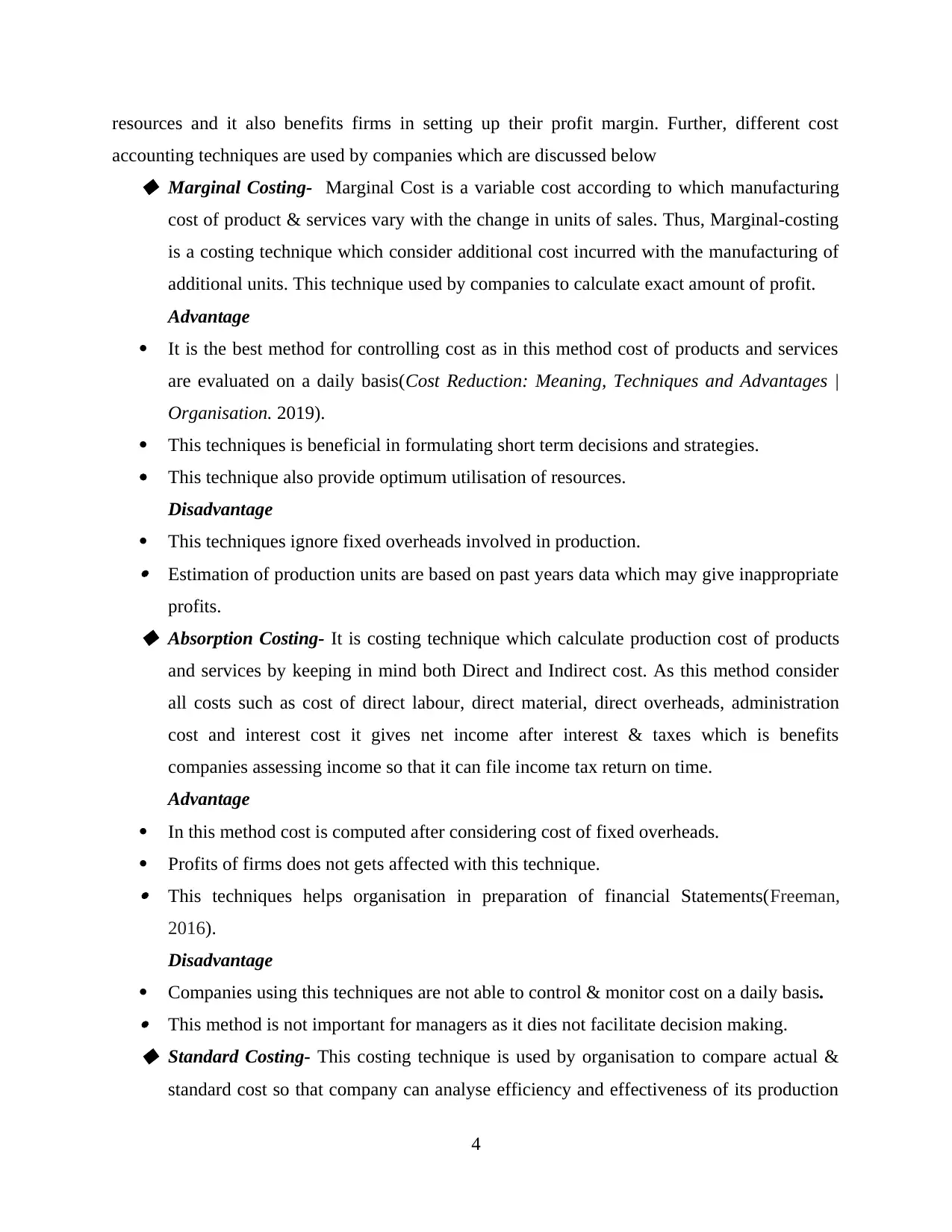
resources and it also benefits firms in setting up their profit margin. Further, different cost
accounting techniques are used by companies which are discussed below Marginal Costing- Marginal Cost is a variable cost according to which manufacturing
cost of product & services vary with the change in units of sales. Thus, Marginal-costing
is a costing technique which consider additional cost incurred with the manufacturing of
additional units. This technique used by companies to calculate exact amount of profit.
Advantage
It is the best method for controlling cost as in this method cost of products and services
are evaluated on a daily basis(Cost Reduction: Meaning, Techniques and Advantages |
Organisation. 2019).
This techniques is beneficial in formulating short term decisions and strategies.
This technique also provide optimum utilisation of resources.
Disadvantage
This techniques ignore fixed overheads involved in production. Estimation of production units are based on past years data which may give inappropriate
profits. Absorption Costing- It is costing technique which calculate production cost of products
and services by keeping in mind both Direct and Indirect cost. As this method consider
all costs such as cost of direct labour, direct material, direct overheads, administration
cost and interest cost it gives net income after interest & taxes which is benefits
companies assessing income so that it can file income tax return on time.
Advantage
In this method cost is computed after considering cost of fixed overheads.
Profits of firms does not gets affected with this technique. This techniques helps organisation in preparation of financial Statements(Freeman,
2016).
Disadvantage
Companies using this techniques are not able to control & monitor cost on a daily basis. This method is not important for managers as it dies not facilitate decision making. Standard Costing- This costing technique is used by organisation to compare actual &
standard cost so that company can analyse efficiency and effectiveness of its production
4
accounting techniques are used by companies which are discussed below Marginal Costing- Marginal Cost is a variable cost according to which manufacturing
cost of product & services vary with the change in units of sales. Thus, Marginal-costing
is a costing technique which consider additional cost incurred with the manufacturing of
additional units. This technique used by companies to calculate exact amount of profit.
Advantage
It is the best method for controlling cost as in this method cost of products and services
are evaluated on a daily basis(Cost Reduction: Meaning, Techniques and Advantages |
Organisation. 2019).
This techniques is beneficial in formulating short term decisions and strategies.
This technique also provide optimum utilisation of resources.
Disadvantage
This techniques ignore fixed overheads involved in production. Estimation of production units are based on past years data which may give inappropriate
profits. Absorption Costing- It is costing technique which calculate production cost of products
and services by keeping in mind both Direct and Indirect cost. As this method consider
all costs such as cost of direct labour, direct material, direct overheads, administration
cost and interest cost it gives net income after interest & taxes which is benefits
companies assessing income so that it can file income tax return on time.
Advantage
In this method cost is computed after considering cost of fixed overheads.
Profits of firms does not gets affected with this technique. This techniques helps organisation in preparation of financial Statements(Freeman,
2016).
Disadvantage
Companies using this techniques are not able to control & monitor cost on a daily basis. This method is not important for managers as it dies not facilitate decision making. Standard Costing- This costing technique is used by organisation to compare actual &
standard cost so that company can analyse efficiency and effectiveness of its production
4
⊘ This is a preview!⊘
Do you want full access?
Subscribe today to unlock all pages.

Trusted by 1+ million students worldwide
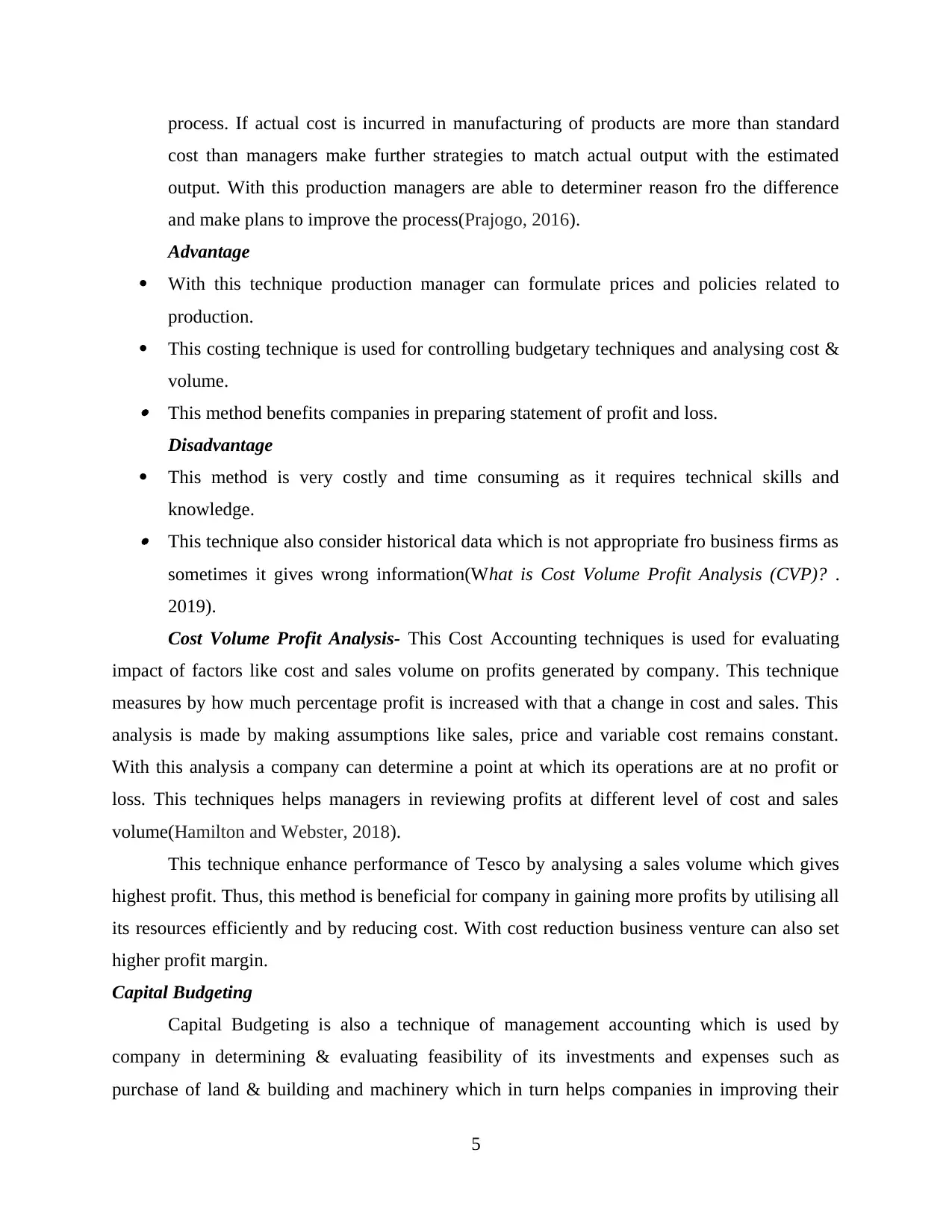
process. If actual cost is incurred in manufacturing of products are more than standard
cost than managers make further strategies to match actual output with the estimated
output. With this production managers are able to determiner reason fro the difference
and make plans to improve the process(Prajogo, 2016).
Advantage
With this technique production manager can formulate prices and policies related to
production.
This costing technique is used for controlling budgetary techniques and analysing cost &
volume. This method benefits companies in preparing statement of profit and loss.
Disadvantage
This method is very costly and time consuming as it requires technical skills and
knowledge. This technique also consider historical data which is not appropriate fro business firms as
sometimes it gives wrong information(What is Cost Volume Profit Analysis (CVP)? .
2019).
Cost Volume Profit Analysis- This Cost Accounting techniques is used for evaluating
impact of factors like cost and sales volume on profits generated by company. This technique
measures by how much percentage profit is increased with that a change in cost and sales. This
analysis is made by making assumptions like sales, price and variable cost remains constant.
With this analysis a company can determine a point at which its operations are at no profit or
loss. This techniques helps managers in reviewing profits at different level of cost and sales
volume(Hamilton and Webster, 2018).
This technique enhance performance of Tesco by analysing a sales volume which gives
highest profit. Thus, this method is beneficial for company in gaining more profits by utilising all
its resources efficiently and by reducing cost. With cost reduction business venture can also set
higher profit margin.
Capital Budgeting
Capital Budgeting is also a technique of management accounting which is used by
company in determining & evaluating feasibility of its investments and expenses such as
purchase of land & building and machinery which in turn helps companies in improving their
5
cost than managers make further strategies to match actual output with the estimated
output. With this production managers are able to determiner reason fro the difference
and make plans to improve the process(Prajogo, 2016).
Advantage
With this technique production manager can formulate prices and policies related to
production.
This costing technique is used for controlling budgetary techniques and analysing cost &
volume. This method benefits companies in preparing statement of profit and loss.
Disadvantage
This method is very costly and time consuming as it requires technical skills and
knowledge. This technique also consider historical data which is not appropriate fro business firms as
sometimes it gives wrong information(What is Cost Volume Profit Analysis (CVP)? .
2019).
Cost Volume Profit Analysis- This Cost Accounting techniques is used for evaluating
impact of factors like cost and sales volume on profits generated by company. This technique
measures by how much percentage profit is increased with that a change in cost and sales. This
analysis is made by making assumptions like sales, price and variable cost remains constant.
With this analysis a company can determine a point at which its operations are at no profit or
loss. This techniques helps managers in reviewing profits at different level of cost and sales
volume(Hamilton and Webster, 2018).
This technique enhance performance of Tesco by analysing a sales volume which gives
highest profit. Thus, this method is beneficial for company in gaining more profits by utilising all
its resources efficiently and by reducing cost. With cost reduction business venture can also set
higher profit margin.
Capital Budgeting
Capital Budgeting is also a technique of management accounting which is used by
company in determining & evaluating feasibility of its investments and expenses such as
purchase of land & building and machinery which in turn helps companies in improving their
5
Paraphrase This Document
Need a fresh take? Get an instant paraphrase of this document with our AI Paraphraser
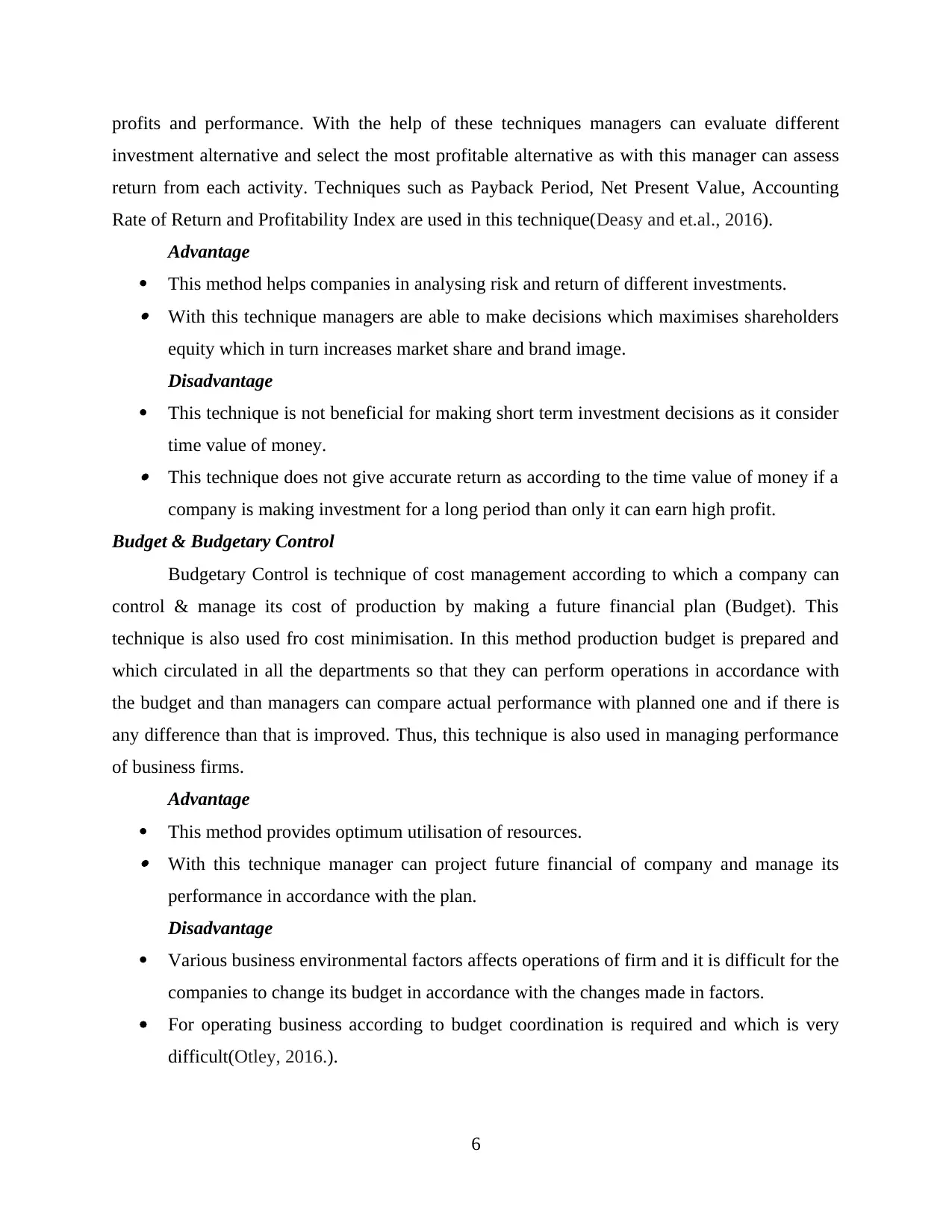
profits and performance. With the help of these techniques managers can evaluate different
investment alternative and select the most profitable alternative as with this manager can assess
return from each activity. Techniques such as Payback Period, Net Present Value, Accounting
Rate of Return and Profitability Index are used in this technique(Deasy and et.al., 2016).
Advantage
This method helps companies in analysing risk and return of different investments. With this technique managers are able to make decisions which maximises shareholders
equity which in turn increases market share and brand image.
Disadvantage
This technique is not beneficial for making short term investment decisions as it consider
time value of money. This technique does not give accurate return as according to the time value of money if a
company is making investment for a long period than only it can earn high profit.
Budget & Budgetary Control
Budgetary Control is technique of cost management according to which a company can
control & manage its cost of production by making a future financial plan (Budget). This
technique is also used fro cost minimisation. In this method production budget is prepared and
which circulated in all the departments so that they can perform operations in accordance with
the budget and than managers can compare actual performance with planned one and if there is
any difference than that is improved. Thus, this technique is also used in managing performance
of business firms.
Advantage
This method provides optimum utilisation of resources. With this technique manager can project future financial of company and manage its
performance in accordance with the plan.
Disadvantage
Various business environmental factors affects operations of firm and it is difficult for the
companies to change its budget in accordance with the changes made in factors.
For operating business according to budget coordination is required and which is very
difficult(Otley, 2016.).
6
investment alternative and select the most profitable alternative as with this manager can assess
return from each activity. Techniques such as Payback Period, Net Present Value, Accounting
Rate of Return and Profitability Index are used in this technique(Deasy and et.al., 2016).
Advantage
This method helps companies in analysing risk and return of different investments. With this technique managers are able to make decisions which maximises shareholders
equity which in turn increases market share and brand image.
Disadvantage
This technique is not beneficial for making short term investment decisions as it consider
time value of money. This technique does not give accurate return as according to the time value of money if a
company is making investment for a long period than only it can earn high profit.
Budget & Budgetary Control
Budgetary Control is technique of cost management according to which a company can
control & manage its cost of production by making a future financial plan (Budget). This
technique is also used fro cost minimisation. In this method production budget is prepared and
which circulated in all the departments so that they can perform operations in accordance with
the budget and than managers can compare actual performance with planned one and if there is
any difference than that is improved. Thus, this technique is also used in managing performance
of business firms.
Advantage
This method provides optimum utilisation of resources. With this technique manager can project future financial of company and manage its
performance in accordance with the plan.
Disadvantage
Various business environmental factors affects operations of firm and it is difficult for the
companies to change its budget in accordance with the changes made in factors.
For operating business according to budget coordination is required and which is very
difficult(Otley, 2016.).
6
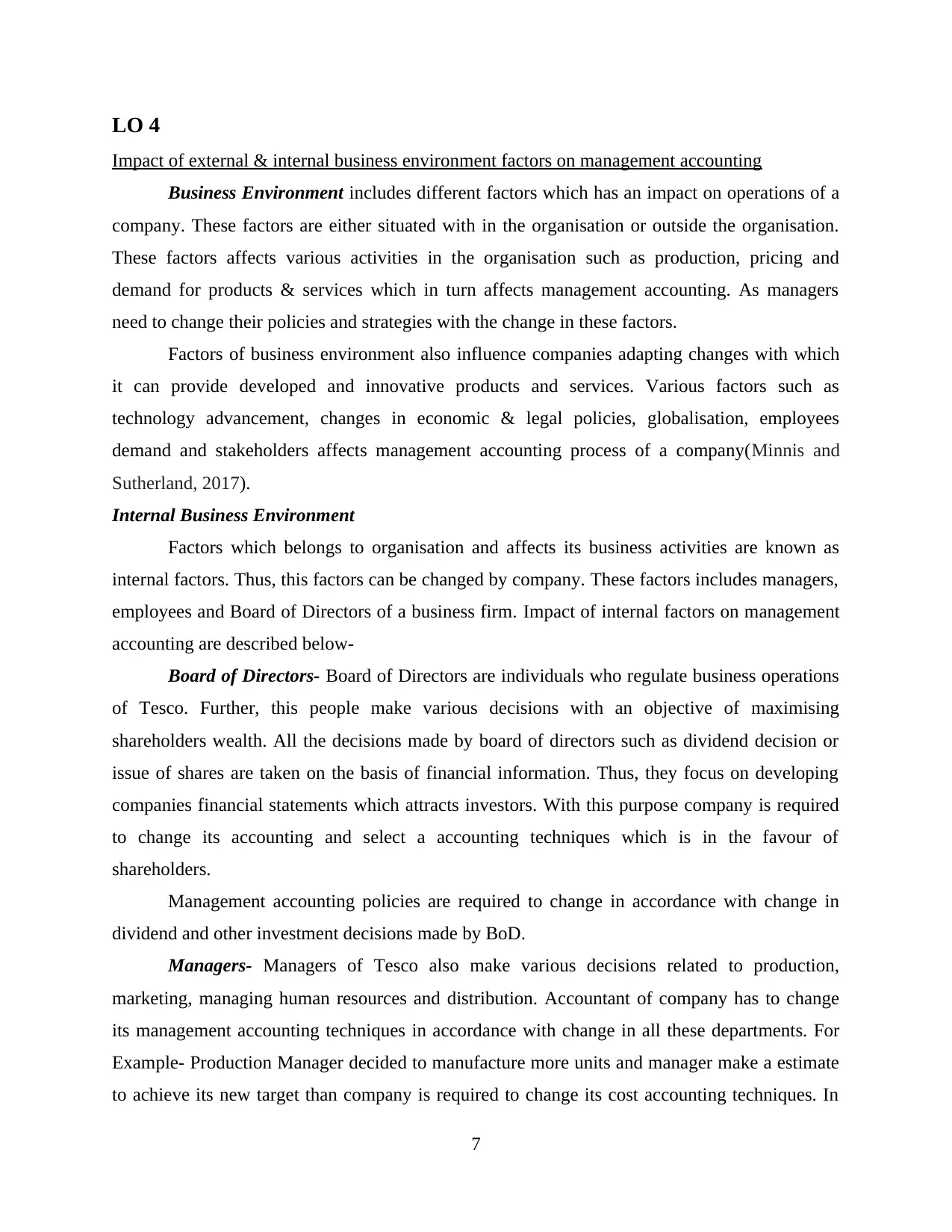
LO 4
Impact of external & internal business environment factors on management accounting
Business Environment includes different factors which has an impact on operations of a
company. These factors are either situated with in the organisation or outside the organisation.
These factors affects various activities in the organisation such as production, pricing and
demand for products & services which in turn affects management accounting. As managers
need to change their policies and strategies with the change in these factors.
Factors of business environment also influence companies adapting changes with which
it can provide developed and innovative products and services. Various factors such as
technology advancement, changes in economic & legal policies, globalisation, employees
demand and stakeholders affects management accounting process of a company(Minnis and
Sutherland, 2017).
Internal Business Environment
Factors which belongs to organisation and affects its business activities are known as
internal factors. Thus, this factors can be changed by company. These factors includes managers,
employees and Board of Directors of a business firm. Impact of internal factors on management
accounting are described below-
Board of Directors- Board of Directors are individuals who regulate business operations
of Tesco. Further, this people make various decisions with an objective of maximising
shareholders wealth. All the decisions made by board of directors such as dividend decision or
issue of shares are taken on the basis of financial information. Thus, they focus on developing
companies financial statements which attracts investors. With this purpose company is required
to change its accounting and select a accounting techniques which is in the favour of
shareholders.
Management accounting policies are required to change in accordance with change in
dividend and other investment decisions made by BoD.
Managers- Managers of Tesco also make various decisions related to production,
marketing, managing human resources and distribution. Accountant of company has to change
its management accounting techniques in accordance with change in all these departments. For
Example- Production Manager decided to manufacture more units and manager make a estimate
to achieve its new target than company is required to change its cost accounting techniques. In
7
Impact of external & internal business environment factors on management accounting
Business Environment includes different factors which has an impact on operations of a
company. These factors are either situated with in the organisation or outside the organisation.
These factors affects various activities in the organisation such as production, pricing and
demand for products & services which in turn affects management accounting. As managers
need to change their policies and strategies with the change in these factors.
Factors of business environment also influence companies adapting changes with which
it can provide developed and innovative products and services. Various factors such as
technology advancement, changes in economic & legal policies, globalisation, employees
demand and stakeholders affects management accounting process of a company(Minnis and
Sutherland, 2017).
Internal Business Environment
Factors which belongs to organisation and affects its business activities are known as
internal factors. Thus, this factors can be changed by company. These factors includes managers,
employees and Board of Directors of a business firm. Impact of internal factors on management
accounting are described below-
Board of Directors- Board of Directors are individuals who regulate business operations
of Tesco. Further, this people make various decisions with an objective of maximising
shareholders wealth. All the decisions made by board of directors such as dividend decision or
issue of shares are taken on the basis of financial information. Thus, they focus on developing
companies financial statements which attracts investors. With this purpose company is required
to change its accounting and select a accounting techniques which is in the favour of
shareholders.
Management accounting policies are required to change in accordance with change in
dividend and other investment decisions made by BoD.
Managers- Managers of Tesco also make various decisions related to production,
marketing, managing human resources and distribution. Accountant of company has to change
its management accounting techniques in accordance with change in all these departments. For
Example- Production Manager decided to manufacture more units and manager make a estimate
to achieve its new target than company is required to change its cost accounting techniques. In
7
⊘ This is a preview!⊘
Do you want full access?
Subscribe today to unlock all pages.

Trusted by 1+ million students worldwide
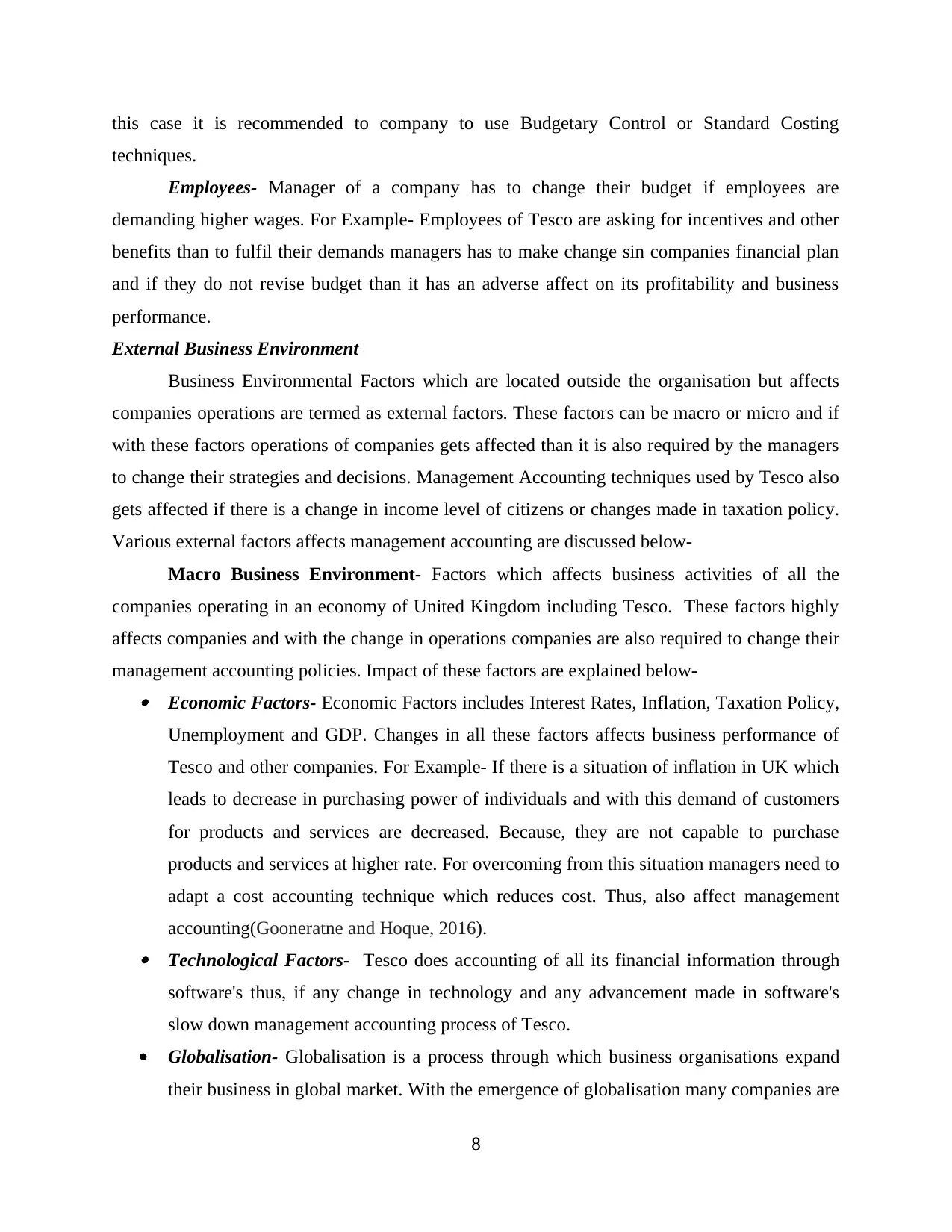
this case it is recommended to company to use Budgetary Control or Standard Costing
techniques.
Employees- Manager of a company has to change their budget if employees are
demanding higher wages. For Example- Employees of Tesco are asking for incentives and other
benefits than to fulfil their demands managers has to make change sin companies financial plan
and if they do not revise budget than it has an adverse affect on its profitability and business
performance.
External Business Environment
Business Environmental Factors which are located outside the organisation but affects
companies operations are termed as external factors. These factors can be macro or micro and if
with these factors operations of companies gets affected than it is also required by the managers
to change their strategies and decisions. Management Accounting techniques used by Tesco also
gets affected if there is a change in income level of citizens or changes made in taxation policy.
Various external factors affects management accounting are discussed below-
Macro Business Environment- Factors which affects business activities of all the
companies operating in an economy of United Kingdom including Tesco. These factors highly
affects companies and with the change in operations companies are also required to change their
management accounting policies. Impact of these factors are explained below- Economic Factors- Economic Factors includes Interest Rates, Inflation, Taxation Policy,
Unemployment and GDP. Changes in all these factors affects business performance of
Tesco and other companies. For Example- If there is a situation of inflation in UK which
leads to decrease in purchasing power of individuals and with this demand of customers
for products and services are decreased. Because, they are not capable to purchase
products and services at higher rate. For overcoming from this situation managers need to
adapt a cost accounting technique which reduces cost. Thus, also affect management
accounting(Gooneratne and Hoque, 2016). Technological Factors- Tesco does accounting of all its financial information through
software's thus, if any change in technology and any advancement made in software's
slow down management accounting process of Tesco.
Globalisation- Globalisation is a process through which business organisations expand
their business in global market. With the emergence of globalisation many companies are
8
techniques.
Employees- Manager of a company has to change their budget if employees are
demanding higher wages. For Example- Employees of Tesco are asking for incentives and other
benefits than to fulfil their demands managers has to make change sin companies financial plan
and if they do not revise budget than it has an adverse affect on its profitability and business
performance.
External Business Environment
Business Environmental Factors which are located outside the organisation but affects
companies operations are termed as external factors. These factors can be macro or micro and if
with these factors operations of companies gets affected than it is also required by the managers
to change their strategies and decisions. Management Accounting techniques used by Tesco also
gets affected if there is a change in income level of citizens or changes made in taxation policy.
Various external factors affects management accounting are discussed below-
Macro Business Environment- Factors which affects business activities of all the
companies operating in an economy of United Kingdom including Tesco. These factors highly
affects companies and with the change in operations companies are also required to change their
management accounting policies. Impact of these factors are explained below- Economic Factors- Economic Factors includes Interest Rates, Inflation, Taxation Policy,
Unemployment and GDP. Changes in all these factors affects business performance of
Tesco and other companies. For Example- If there is a situation of inflation in UK which
leads to decrease in purchasing power of individuals and with this demand of customers
for products and services are decreased. Because, they are not capable to purchase
products and services at higher rate. For overcoming from this situation managers need to
adapt a cost accounting technique which reduces cost. Thus, also affect management
accounting(Gooneratne and Hoque, 2016). Technological Factors- Tesco does accounting of all its financial information through
software's thus, if any change in technology and any advancement made in software's
slow down management accounting process of Tesco.
Globalisation- Globalisation is a process through which business organisations expand
their business in global market. With the emergence of globalisation many companies are
8
Paraphrase This Document
Need a fresh take? Get an instant paraphrase of this document with our AI Paraphraser
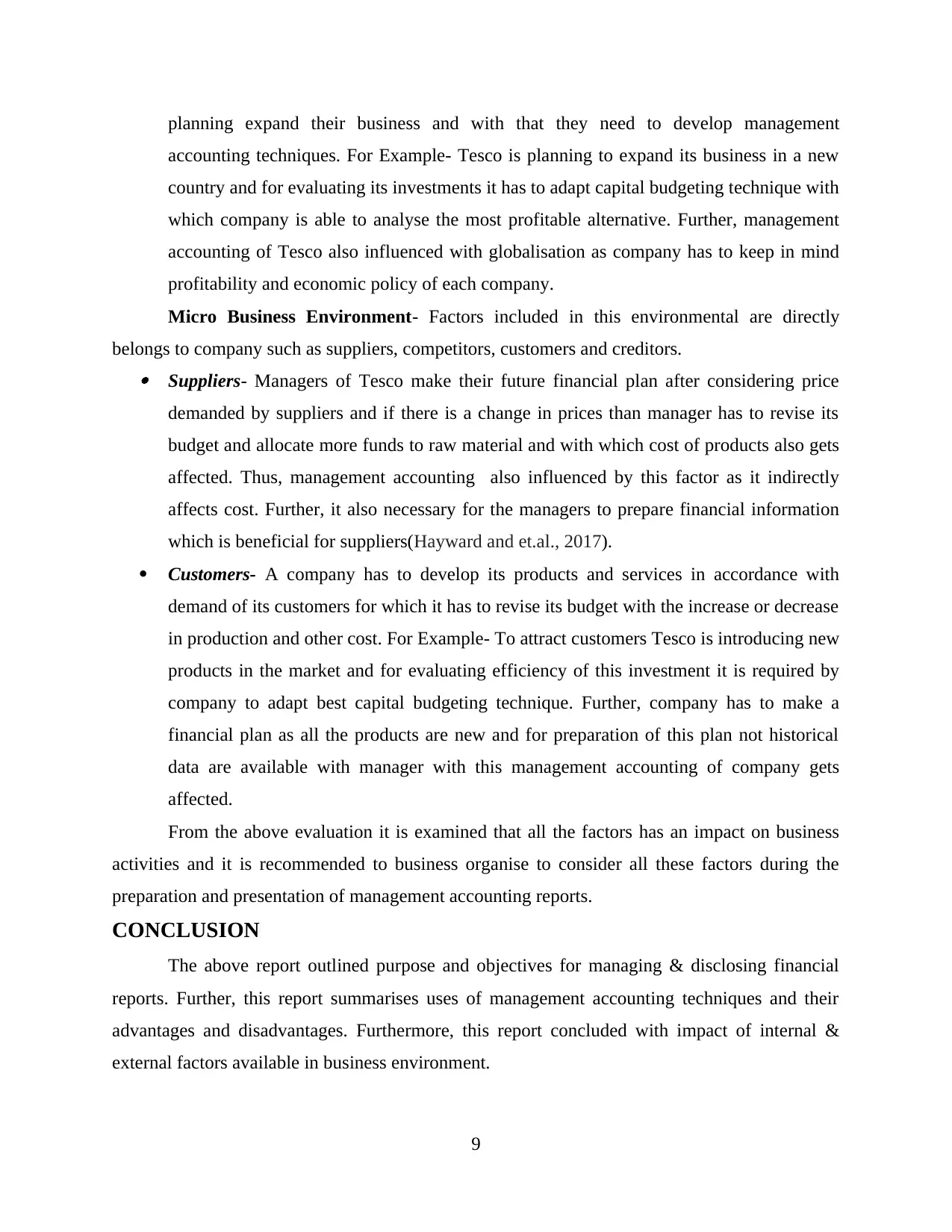
planning expand their business and with that they need to develop management
accounting techniques. For Example- Tesco is planning to expand its business in a new
country and for evaluating its investments it has to adapt capital budgeting technique with
which company is able to analyse the most profitable alternative. Further, management
accounting of Tesco also influenced with globalisation as company has to keep in mind
profitability and economic policy of each company.
Micro Business Environment- Factors included in this environmental are directly
belongs to company such as suppliers, competitors, customers and creditors. Suppliers- Managers of Tesco make their future financial plan after considering price
demanded by suppliers and if there is a change in prices than manager has to revise its
budget and allocate more funds to raw material and with which cost of products also gets
affected. Thus, management accounting also influenced by this factor as it indirectly
affects cost. Further, it also necessary for the managers to prepare financial information
which is beneficial for suppliers(Hayward and et.al., 2017).
Customers- A company has to develop its products and services in accordance with
demand of its customers for which it has to revise its budget with the increase or decrease
in production and other cost. For Example- To attract customers Tesco is introducing new
products in the market and for evaluating efficiency of this investment it is required by
company to adapt best capital budgeting technique. Further, company has to make a
financial plan as all the products are new and for preparation of this plan not historical
data are available with manager with this management accounting of company gets
affected.
From the above evaluation it is examined that all the factors has an impact on business
activities and it is recommended to business organise to consider all these factors during the
preparation and presentation of management accounting reports.
CONCLUSION
The above report outlined purpose and objectives for managing & disclosing financial
reports. Further, this report summarises uses of management accounting techniques and their
advantages and disadvantages. Furthermore, this report concluded with impact of internal &
external factors available in business environment.
9
accounting techniques. For Example- Tesco is planning to expand its business in a new
country and for evaluating its investments it has to adapt capital budgeting technique with
which company is able to analyse the most profitable alternative. Further, management
accounting of Tesco also influenced with globalisation as company has to keep in mind
profitability and economic policy of each company.
Micro Business Environment- Factors included in this environmental are directly
belongs to company such as suppliers, competitors, customers and creditors. Suppliers- Managers of Tesco make their future financial plan after considering price
demanded by suppliers and if there is a change in prices than manager has to revise its
budget and allocate more funds to raw material and with which cost of products also gets
affected. Thus, management accounting also influenced by this factor as it indirectly
affects cost. Further, it also necessary for the managers to prepare financial information
which is beneficial for suppliers(Hayward and et.al., 2017).
Customers- A company has to develop its products and services in accordance with
demand of its customers for which it has to revise its budget with the increase or decrease
in production and other cost. For Example- To attract customers Tesco is introducing new
products in the market and for evaluating efficiency of this investment it is required by
company to adapt best capital budgeting technique. Further, company has to make a
financial plan as all the products are new and for preparation of this plan not historical
data are available with manager with this management accounting of company gets
affected.
From the above evaluation it is examined that all the factors has an impact on business
activities and it is recommended to business organise to consider all these factors during the
preparation and presentation of management accounting reports.
CONCLUSION
The above report outlined purpose and objectives for managing & disclosing financial
reports. Further, this report summarises uses of management accounting techniques and their
advantages and disadvantages. Furthermore, this report concluded with impact of internal &
external factors available in business environment.
9
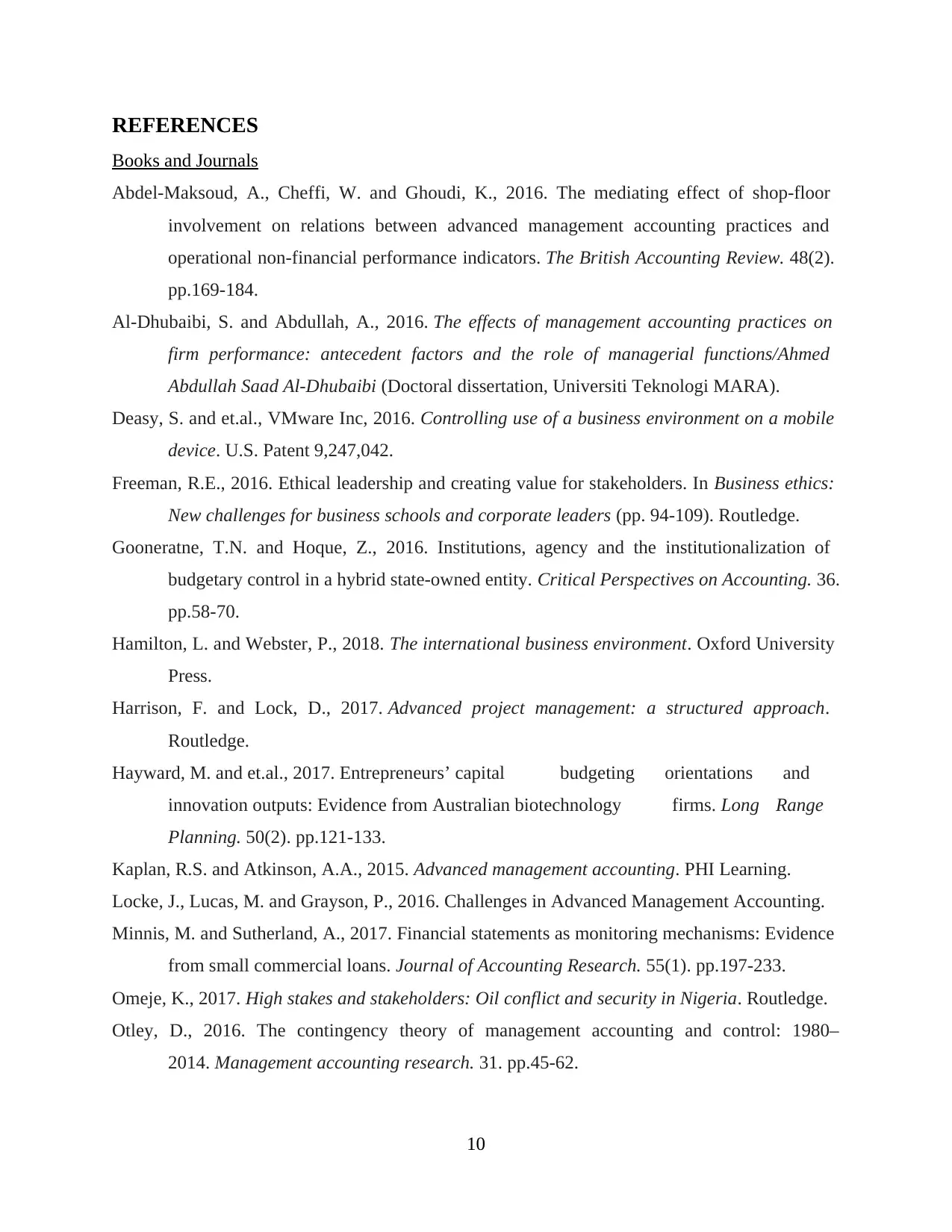
REFERENCES
Books and Journals
Abdel-Maksoud, A., Cheffi, W. and Ghoudi, K., 2016. The mediating effect of shop-floor
involvement on relations between advanced management accounting practices and
operational non-financial performance indicators. The British Accounting Review. 48(2).
pp.169-184.
Al-Dhubaibi, S. and Abdullah, A., 2016. The effects of management accounting practices on
firm performance: antecedent factors and the role of managerial functions/Ahmed
Abdullah Saad Al-Dhubaibi (Doctoral dissertation, Universiti Teknologi MARA).
Deasy, S. and et.al., VMware Inc, 2016. Controlling use of a business environment on a mobile
device. U.S. Patent 9,247,042.
Freeman, R.E., 2016. Ethical leadership and creating value for stakeholders. In Business ethics:
New challenges for business schools and corporate leaders (pp. 94-109). Routledge.
Gooneratne, T.N. and Hoque, Z., 2016. Institutions, agency and the institutionalization of
budgetary control in a hybrid state-owned entity. Critical Perspectives on Accounting. 36.
pp.58-70.
Hamilton, L. and Webster, P., 2018. The international business environment. Oxford University
Press.
Harrison, F. and Lock, D., 2017. Advanced project management: a structured approach.
Routledge.
Hayward, M. and et.al., 2017. Entrepreneurs’ capital budgeting orientations and
innovation outputs: Evidence from Australian biotechnology firms. Long Range
Planning. 50(2). pp.121-133.
Kaplan, R.S. and Atkinson, A.A., 2015. Advanced management accounting. PHI Learning.
Locke, J., Lucas, M. and Grayson, P., 2016. Challenges in Advanced Management Accounting.
Minnis, M. and Sutherland, A., 2017. Financial statements as monitoring mechanisms: Evidence
from small commercial loans. Journal of Accounting Research. 55(1). pp.197-233.
Omeje, K., 2017. High stakes and stakeholders: Oil conflict and security in Nigeria. Routledge.
Otley, D., 2016. The contingency theory of management accounting and control: 1980–
2014. Management accounting research. 31. pp.45-62.
10
Books and Journals
Abdel-Maksoud, A., Cheffi, W. and Ghoudi, K., 2016. The mediating effect of shop-floor
involvement on relations between advanced management accounting practices and
operational non-financial performance indicators. The British Accounting Review. 48(2).
pp.169-184.
Al-Dhubaibi, S. and Abdullah, A., 2016. The effects of management accounting practices on
firm performance: antecedent factors and the role of managerial functions/Ahmed
Abdullah Saad Al-Dhubaibi (Doctoral dissertation, Universiti Teknologi MARA).
Deasy, S. and et.al., VMware Inc, 2016. Controlling use of a business environment on a mobile
device. U.S. Patent 9,247,042.
Freeman, R.E., 2016. Ethical leadership and creating value for stakeholders. In Business ethics:
New challenges for business schools and corporate leaders (pp. 94-109). Routledge.
Gooneratne, T.N. and Hoque, Z., 2016. Institutions, agency and the institutionalization of
budgetary control in a hybrid state-owned entity. Critical Perspectives on Accounting. 36.
pp.58-70.
Hamilton, L. and Webster, P., 2018. The international business environment. Oxford University
Press.
Harrison, F. and Lock, D., 2017. Advanced project management: a structured approach.
Routledge.
Hayward, M. and et.al., 2017. Entrepreneurs’ capital budgeting orientations and
innovation outputs: Evidence from Australian biotechnology firms. Long Range
Planning. 50(2). pp.121-133.
Kaplan, R.S. and Atkinson, A.A., 2015. Advanced management accounting. PHI Learning.
Locke, J., Lucas, M. and Grayson, P., 2016. Challenges in Advanced Management Accounting.
Minnis, M. and Sutherland, A., 2017. Financial statements as monitoring mechanisms: Evidence
from small commercial loans. Journal of Accounting Research. 55(1). pp.197-233.
Omeje, K., 2017. High stakes and stakeholders: Oil conflict and security in Nigeria. Routledge.
Otley, D., 2016. The contingency theory of management accounting and control: 1980–
2014. Management accounting research. 31. pp.45-62.
10
⊘ This is a preview!⊘
Do you want full access?
Subscribe today to unlock all pages.

Trusted by 1+ million students worldwide
1 out of 13
Related Documents
Your All-in-One AI-Powered Toolkit for Academic Success.
+13062052269
info@desklib.com
Available 24*7 on WhatsApp / Email
![[object Object]](/_next/static/media/star-bottom.7253800d.svg)
Unlock your academic potential
Copyright © 2020–2025 A2Z Services. All Rights Reserved. Developed and managed by ZUCOL.





